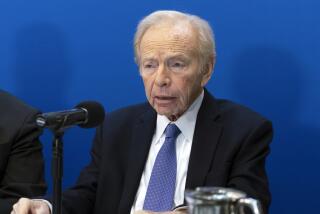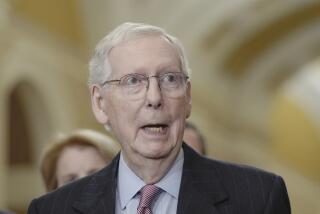Bob Dole’s Ever-Evolving Public Image
- Share via
WASHINGTON — There’s agreement in Washington that Senate Majority Leader Bob Dole (R-Kan.) has already enjoyed one of the most important public image transformations of the last decade. He has metamorphosed from 1976’s much-criticized Republican vice presidential candidate- cum -hatchet man into a leading policy-maker, spotlighted by one news magazine as the “hot” emerging challenger to Vice President George Bush for the 1988 GOP presidential nomination. Which leads to another question: Could Dole go all the way?
It won’t be easy. But while the senator from Kansas was once the incipient Rodney Dangerfield of the wheat belt, the current measure of his respect was underscored by the million-dollar receipts from a Washington reception he recently gave to help his Dole Foundation for Employment of Persons with Disabilities. Dole’s interest in the disabilities of others basically grows out of his own: He has little use of his right arm, shattered in World War II. But because of the majority leader’s influence, crowds of power brokers have lined up to finance a foundation that essentially gives grants to help crippled children. It’s part of the changing perception of Dole. Press reports even evoke analogies to Franklin D. Roosevelt and his role in the March of Dimes.
Yet, despite the growing belief among political insiders that a matured Dole could make a good President, few think fate will deal him the chance. To begin with, Dole’s current, second-place standing in most Republican preference polls is more marginal than solid. Bush is far ahead, and Dole’s 10%-15% puts him second largely because the other two major contenders--former Senate Majority Leader Howard H. Baker Jr. and Rep. Jack Kemp of New York--have been sagging. Then there’s the bad precedent of Dole’s 1976 vice presidential defeat, followed by his inept 1980 bid for the GOP presidential nomination. Second-place nominees on a losing national ticket may make personal and professional comebacks, but it’s rare that they convince their party to give them another nomination, this time for the presidency.
Which brings us to what is at once Dole’s 1988 launching pad and his prime 1988 obstacle--his GOP Senate leadership. Ironically, the turnaround in Dole’s fortunes dates from the emergence of Ronald Reagan in 1980. First came the Reagan landslide, with its corollary of the first Republican Senate in a generation. Then, as the post-1981 context of Washington politics began to lurch to the right, Dole, whose 1976 conservatism had seemed abrasive, was perceived as a centrist. Dole himself changed--his bitter partisanship ebbed as his self-confidence grew. But, in addition, a new generation of zealots and abstractionists took conservatism too far right for a farm-belt pragmatist, whatever his prior combativeness. Finally, the GOP’s new majority circumstances showcased Dole’s legislative talents. Seniority made him Senate Finance Committee chairman, a position he soon parlayed into leadership of the Republican Party’s fiscal-responsibility wing. If Dole’s willingness to support tax increases in 1982 and 1984 made him enemies on the supply-side ideological right, it gave him stature among hitherto skeptical Establishment constituencies.
Come December, 1984, Dole’s success in winning the Senate Republican majority leader’s post boosted him to a larger platform. And during the spring and summer of 1985, he used it to carve out a profile of dissent from Reagan Administration budget-deficit nonchalance. That helped him in the polls. Indeed, from an institutional standpoint, captaincy of the centrist Republican forces on Capitol Hill during the Reagan Era seems to have worked to position the Senate party leader--first Baker, then Dole--to emerge as a prime presidential contender and moderate GOP rallying point.
Since Baker retired in 1984 (ironically, to concentrate on running for President), Dole is the one who has climbed in the polls--to a point where Baker’s candidacy is in some doubt. Meanwhile, there are already signs that televising the Senate has given Dole a benefit no prior majority leader ever enjoyed.
The problem is that no one should overstate the usefulness of the Senate majority leadership as a presidential launching pad. Pre-television, it wasn’t one. Occupants were positioned, but not launched. Lyndon B. Johnson’s success in going from Senate majority leader in 1960 to vice president in 1961 and then President on the death of John F. Kennedy in 1963 is a half-exception. Texas geography got him on the ticket, not his mediocre showings in polls. And an assassin’s bullet made him President.
L.B.J. aside, the rule is that 20th-Century congressional leaders fail in their presidential ambitions--Sen. Robert A. Taft never got the nomination, and neither did such Senate stalwarts as Arthur H. Vandenberg and Henry Cabot Lodge Sr. On the House side, Speaker John Nance Garner was selected vice president by Roosevelt in 1932, but never moved up. And House Speaker James Beauchamp (Champ) Clark lost his powerful 1912 bid for the Democratic presidential nomination on the fifth ballot. The other exception, House GOP leader Gerald R. Ford, became the first appointive vice president in 1973, moving to the Oval Office on Richard M. Nixon’s resignation. But it took two fluky circumstances.
In short, the obstacles facing Dole are formidable. Jumping from the congressional leadership direct to the White House is unprecedented. And a Senate majority leader faces a dubious array of tactical options. Consider:
Serving as Senate Majority Leader in a White House Loyalist Role: This is pretty much what Dole has done for the last six to nine months. As his presidential credibility and poll numbers have strengthened, Dole has tilted toward support of the Reagan White House, cooling his earlier independence.
Carrying water for the White House can yield unfavorable publicity--for example, Dole’s June efforts to win confirmation for the Administration’s controversial federal judicial nominee, Daniel A. Manion. However, White House loyalism has reinforced his earlier ties to the GOP’s dominant right wing and bolstered his ability to claim Reagan heirship in 1988.
And there’s another, more Machiavellian benefit: Being a White House loyalist reduces the extent Dole can be criticized by other GOP senators for using his position to advance personal presidential ambitions. The drawback is that despite Reagan’s popularity, voters will be looking for independence and new ideas in 1988. And serving the next two years as a loyalist could saddle Dole with some of the me-too role that burdens Bush.
Serving as an Independent Senate Majority Leader: Here’s another scenario. Suppose that the Republicans hold the Senate in 1986, but support for Reagan and his policies fades. Then Dole could be tempted to carve out a more independent role for both himself and the Senate GOP. While this might increase his marketability to the overall electorate, it probably wouldn’t help him get the GOP nomination. Reaganites would be offended. So would some Republican senators, ever-suspicious of Dole acting on his own behalf. Moreover, with no modern precedent for a Senate majority leader mounting a successful presidential campaign, it’s hard to say that an independent approach would work any better than a “loyalist” strategy.
Serving as Senate Minority Leader: If there’s minimal evidence that Senate majority leaders can leap from that position into the Oval Office, there’s even less reason to believe the jump can be made by Senate minority leaders--especially ones unlucky enough to preside over their party’s loss of Senate control. Dole has said he’d probably stay on as majority leader in 1987 if the GOP keeps control. But would he stay as minority leader? And could he?
Serving as an Ordinary Senator: Holding onto the majority leadership could reward Dole. But accepting a comedown to managing a 1987-88 Senate GOP in minority status probably would not. By contrast, as an ordinary senator running for President, Dole could stake out independent positions and new ideas without being hobbled by party leadership responsibilities. This, in fact, has been the way most successful and nearly successful senators have run for presidential nominations--John F. Kennedy in 1960, Barry M. Goldwater in 1964, George McGovern in 1972 and Gary Hart in 1984.
In sum, Dole, for all his talents and Washington esteem, is coming up against a reality of U.S. politics: Leaders of Congress almost never leap to the presidency. From Henry Clay, Daniel Webster and John C. Calhoun down to the more recent example of Taft, executive ambitions haven’t squared with legislative circumstances. And the latter has prevailed. Yet there is an encouraging item for Dole in the history books: One man did run a losing race for the vice presidency, and then, 12 years later, made it to the White House. His name was Franklin D. Roosevelt.
More to Read
Get the L.A. Times Politics newsletter
Deeply reported insights into legislation, politics and policy from Sacramento, Washington and beyond. In your inbox twice per week.
You may occasionally receive promotional content from the Los Angeles Times.










